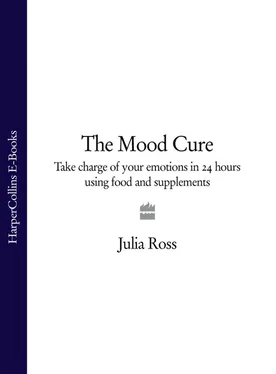I was encouraged by these results, but I also had to admit that it took the clients who were able to stick with it about ten weeks to fully withdraw from their bad-mood junk foods. For most of them, this was ten weeks of food cravings, fatigue, headaches, and only very slowly diminishing mood swings. More important, too many of our clients just couldn’t wait it out and went back to their old junk foods and debilitating moods.
We needed something more.
Around this time, in the mid-1980s, I read about the work of neuroscientist Kenneth Blum, Ph.D., at the University of North Texas. A prolific researcher, Dr. Blum was studying the brain chemistry of alcoholics and drug addicts. In the course of this work, he’d identified a few genes that could hardwire the brain to under produce its most potent “feel good” brain chemicals and instead produce the “feel bad” mood chemistry that made his subjects so vulnerable to addiction. His research explained the perplexing feelings of anxiety, anger, and depression, the chronic insomnia, and the lack of a sense of well-being that plagued so many addicts even in recovery. He called it the “reward deficiency syndrome.” This finding was fascinating all by itself, but Dr. Blum made another, even more remarkable discovery. He found that he could override the bad-mood genes by giving his research subjects a few supplemental nutrients. These brain foods, called amino acids, are concentrates of common proteins found in food. They were able to jump-start the addicts’ genetically misprogrammed brain chemistry and radically improve their moods. The bottom line: The addicts who took the amino acids were able to stay away from drugs and alcohol. Those who took no aminos had four times higher relapse rates! 7
I was very excited after reviewing Dr. Blum’s studies. I had a sense that the amino acids were the missing ingredients in my fledgling nutritional therapy program. Since these supplements were identical to nutrients found in food and, unlike drugs, not foreign to the human body, my nutritionists and I felt comfortable recommending them. It was certainly worth a try.
COMBINING NUTRITHERAPY WITH PSYCHOTHERAPY
Early on, I decided to give the aminos to three women struggling with bulimia, an eating disorder that is normally very difficult to treat. When they came to our clinic, all of them had been working hard in psychotherapy for some time with no improvement. Like most bulimics, they were depressed, obsessive, and self-critical. All were professionally well established, though, and all were married. One was a happily married 26-year-old, one was 35 and very unhappily married, and the third, at 48, needed marital help, but she and her husband were both determined to work things out.
In addition to taking the aminos, these women committed themselves to following our standard program of protein-and-vegetable-rich, reduced-carbohydrate foods and psychotherapy. I was astonished at how the aminos accelerated each client’s progress. Mood improvements that would normally have taken months to achieve began for these women in days. In two weeks on the aminos, all three women had freed themselves of their obsessions with food and most of their associated mood problems. And it kept getting better. After a few months on aminos, the happily married woman, having met all of her goals, graduated from therapy free of both bulimia and mood swings. The unhappily married woman began to do deep and productive therapy after years of being too weakened by her bulimia to use psychotherapy constructively. After her nutritional overhaul, she was able to work through her fears, leave her husband, and establish a happy life for herself. The third woman no longer felt much need for individual therapy (she’d been at it for years) but started couples therapy with good results. All three women were still making excellent progress six months later and starting to go off their aminos. Their psychotherapist was dumbfounded, and so were we.
More than fifteen years and several thousand clients later, the amino acids are still our most effective weapons for fighting false moods. We have consistently found that they not only improve mood almost instantly, but speed up psychotherapy as well. A well-nourished person who has had a brain chemistry tune-up with amino acids gets beyond psychological and emotional obstacles faster, deeper, and more successfully. Not only have our brain-tuned clients had quicker access to critical memories, but they’ve coped better with those memories, no longer paralyzed by biochemically exaggerated feelings of fear, guilt, or pain.
The effects of nutritionally stabilized moods on our clients’ relationships have also been extraordinary. I’ll never forget the first family that we treated with both psychotherapy and nutritherapy. A father and mother came to see us, concerned about their 14-year-old son, who was having attention problems and depression plus headache pain so severe that it often kept him at home from school. It soon became clear that Dad had some serious problems, too. He was obsessively controlling and verbally abusive. Though they had received family counseling many times in the past, nothing had ever improved. When it became clear, after a few sessions, that Dad was actually deeply devoted to his family but simply unable to control his critical, angry feelings, I suggested that he meet with the same staff nutritionist who was seeing his son. He agreed because he could see that his son’s headaches were responding to dietary changes and that his mood and ability to concentrate were improving on the amino acids. When Dad began taking amino acids himself, the change was immediate and powerful: his obsessive, explosive behavior evaporated entirely, much to the amazement and relief of his wife and son. Family therapy proceeded very constructively, since all family members were finally able to listen and respond to one another free of their false moods. Interestingly, Dad also needed some private psychotherapy to adjust to his new emotional style, especially in the business world, where his abrasive personality had become his trademark. In 1995, our staff began suggesting that our clients try potentially helpful aminos right in the office, during their initial assessments. As a result, we’ve actually been present as the amino acids have taken effect, typically within fifteen minutes. We’ve watched and cheered as hundreds of clients shed their false feelings of tension, apathy, irritability, and emotional pain right before our eyes. The word that our clients always use to describe this experience is “amazing.” What’s more, our clients typically need to take the aminos for only three to twelve months. After that, their mood chemistry repairs are usually complete. They must, however, continue eating plenty of protein, vegetables, and other fresh whole foods and taking their basic vitamin, mineral, and fatty acid supplements.
HOW DO THE AMINOS ELIMINATE FALSE MOODS AND REVIVE TRUE EMOTION?
This is the secret: There are twenty-two different kinds of amino acids in high-protein foods like chicken, fish, beef, eggs, and cheese. You may have heard them referred to as the building blocks of protein. Each amino has its own name and unique duties to perform, but only a few very special aminos can serve as fuels for the brain’s four mood engines. Just five or six of these amino acids, taken as supplements, can effectively reverse all four of the brain deficiencies that cause false moods.
Each of the four mood engines in your brain needs a different amino acid fuel. The lower your access to amino fuel, the more false mood symptoms you can develop. The question is how much “gas” do you have in each of your engines? How do you know when you’ve run too low? How can you fill ’em up? Which amino brain fuels do you need? Where can you get them? How long will it take? You’ll soon learn what the best brain foods are for you and how to find and use the amino acid supplements that will jump-start all of your emotional engines and keep them fired up.
Читать дальше












